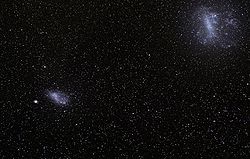Magellanic Clouds
 From Conservapedia
From Conservapedia 
The Magellanic Clouds are two nearby dwarf galaxies that are visible in the southern night sky, which are part of our Local Group of galaxies. They are referred to individually as the Large Magellanic Cloud (LMC) and the Small Magellanic Cloud (SMC). Traditionally thought to be satellite galaxies, gravitationally bound to the Milky Way, more recent observations have challenged that long held notion.
Contents
History of Observation[edit]
As the Magellanic Clouds appear as visible, misty patches in the night sky to the unaided eye, they have been known since the dawn of history to the people of the Southern hemisphere and even as far north as 12° Northern latitude. The people of Polynesia referred to the galaxies as Mahu. The first known recorded mention of the two galaxies is by Persian astronomer Al Sufi in 964 in his record known as the Book of Fixed Stars, naming them al-Bakr, or "the White Ox".[1]
The two galaxies were unknown to Europeans until the end of the 15th century when they were observed by Peter Martyr d'Anghiera and Andreas Corsali and later recorded in the former's writings, collectively known as Decades. Amerigo Vespucci also made mention of the clouds during his third voyage in 1503-4.[2] Later, during the circumnavigation voyage of Ferdinand Magellan (1519–22), they were observed and recorded by the Venetian scholar Antonio Pigafetta, who traveled along. The name "Magellanic Clouds" though did not become associated with the galaxies until much later. In Italian, the Large and Small cloud are called Nube Maggiore and Nube Minore respectively. In French they are Grand Nuage and Petit Nuage, and in German, they are called Grosse Wolke and Kleine Wolke.[1]
Characteristics[edit]
The two Magellanic Clouds were believed to be the closest galaxies to our own until 1994, when the Sagittarius Dwarf Elliptical galaxy was discovered. The two galaxies themselves appear 21° apart in the night sky.
In 2007, a team of astronomers from the Harvard-Smithsonian Center for Astrophysics, using input from the Hubble Telescope accurately measured both the radial and proper velocity of the Magellanic Clouds, which clocked their passage through the region of our galaxy at over 480 km/s. Due to this high relative velocity, it is now believed that the two galaxies are not gravitationally bound satellites of the Milky Way, as once believed, thus requiring a revision of many of the previously assumed effects they have on the Milky Way.[3][4]
Large Magellanic Cloud[edit]
The Large Magellanic Cloud (LMC) was thought to be the closest galaxy to the Milky Way, (the Sagittarius Dwarf Elliptical and Canis Major Dwarf are now known to be closer). From our vantage point on Earth, the galaxy has an apparent magnitude of 0.1 and sits across the constellations of Dorado and Mensa, spanning 8° of the night sky.[5]
The galaxy itself is an irregular dwarf. It holds about one-tenth of the mass of our own Milky Way. A central bar of stars show prominently in its structure, as well as a single spiral arm. The galaxy is considered a treasure trove of celestial phenomena to astronomers, with 60 globular clusters, 400 planetary nebulae, and 700 open clusters identified thus far, along with hundreds of thousands of stars including many supergiants.[6]
Two of the most notable features of the Large Magellanic Cloud are the Tarantula Nebula and the supernova remnant known as Lionel-Murphy SNR. The Tarantula Nebula is the known as the most active region of star formation in the Local Group of galaxies as well as one of the largest nebulae known. Lionel-Murphy SNR is the remains of Supernova 1987a, which occurred in 1987 and was the closest observed supernova to Earth since 1604.
Small Magellanic Cloud[edit]
The Small Magellanic Cloud is the fourth closest galaxy to our own. In the night sky, it is located in the constellation of Tucana, spanning 3° across in the night sky, lying some 20 degrees to the east of the Large Magellanic Cloud.
The galaxy itself may perhaps have once a barred spiral galaxy much like our own, before being disrupted by the Milky Way.[7] Its diameter is 7,000 light years across, and contains hundreds of million of stars with a total mass of one-fifteenth of that of the Milky Way.
The Small Magellanic Cloud's greatest astronomical contribution is that it's the location where Henrietta Swan Leavitt first discovered the definite relationship between the variability period and the luminosity of a type of variable star later called Cepheid variables.[8] Today Cepheid variables are used as standard candles for measuring extra-galactic distances.
References[edit]
- ↑ 1.0 1.1 Allen, Richard Hinkley (1963). Star Names, Their Lore and Meaning. New York: Dover. ISBN 0-486-21079-0. Available online at: penelope.uchicago.edu
- ↑ http://messier.obspm.fr/xtra/Bios/vespucci.html
- ↑ Besla, G., Kallivayalil, N., Hernquist, L., Robertson, B., Cox, T., van der Marel, R. and Alcock, C. (2007). Are the Magellanic Clouds on Their First Passage about the Milky Way?. The Astrophysical Journal, 668(2), pp.949-967. arXiv:astro-ph/0703196
- ↑ The Magellanic Clouds Are First-Time Visitors from cfa.harvard.edu
- ↑ Magellanic Cloud from britannica.com
- ↑ Burnham, Robert, Jr. (1978). Burnham's Celestial Handbook: Volume Two. New York: Dover. p. 840-47. ISBN 048623567X.
- ↑ Small Magellanic Cloud from coolcosmos.ipac.caltech.edu
- ↑ Leavitt, H. (1908). 1777 variables in the Magellanic Clouds. Annals of Harvard College Observatory, 60, pp.87-108.3. Online
| |||||||||||||||||
Categories: [Astronomy] [Galaxies]
↧ Download as ZWI file | Last modified: 02/28/2023 00:26:15 | 30 views
☰ Source: https://www.conservapedia.com/Magellanic_Clouds | License: CC BY-SA 3.0
 ZWI signed:
ZWI signed:
 KSF
KSF